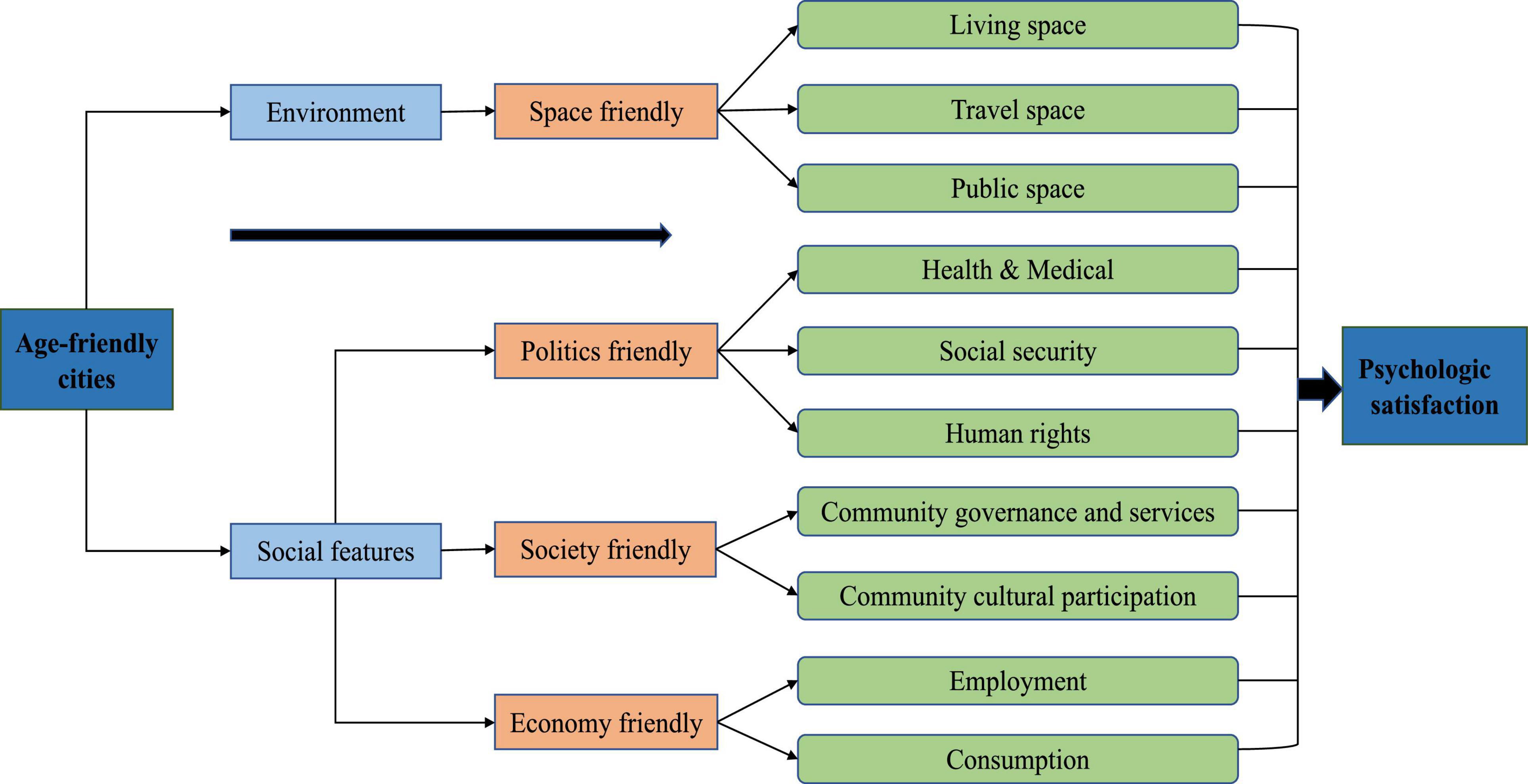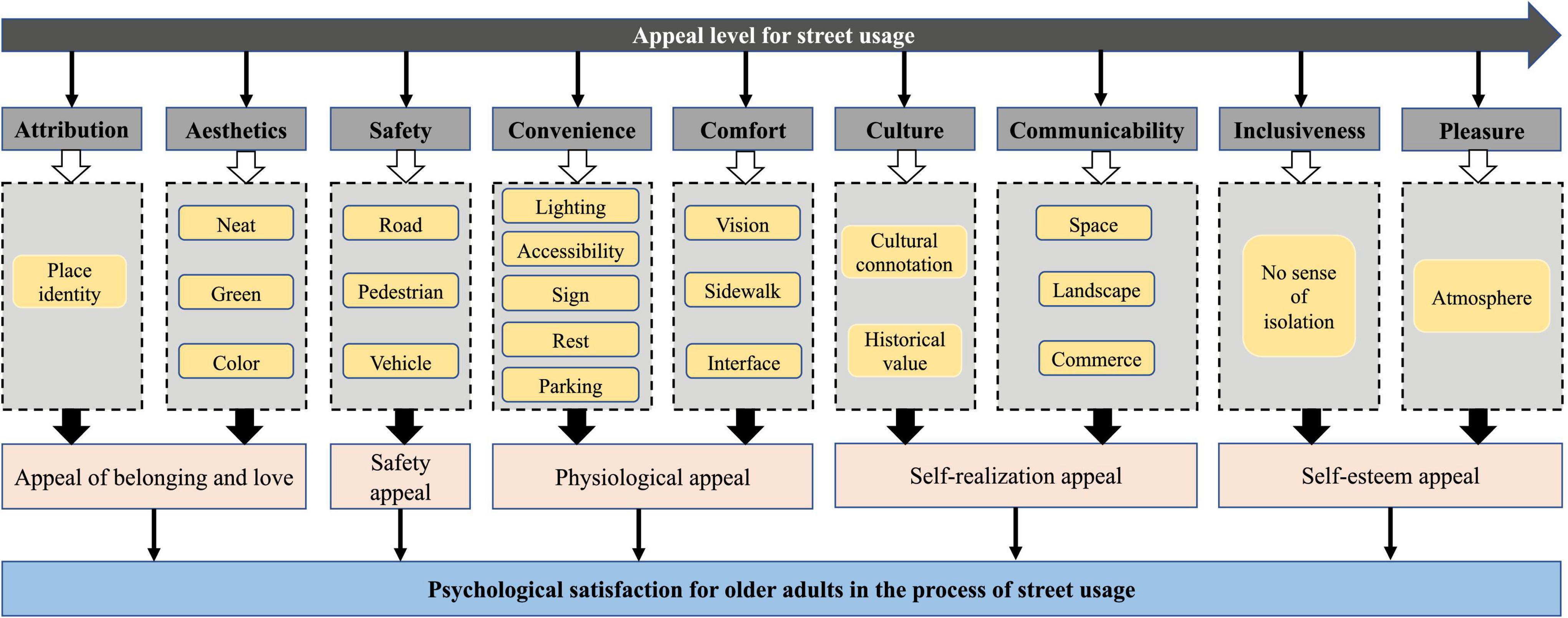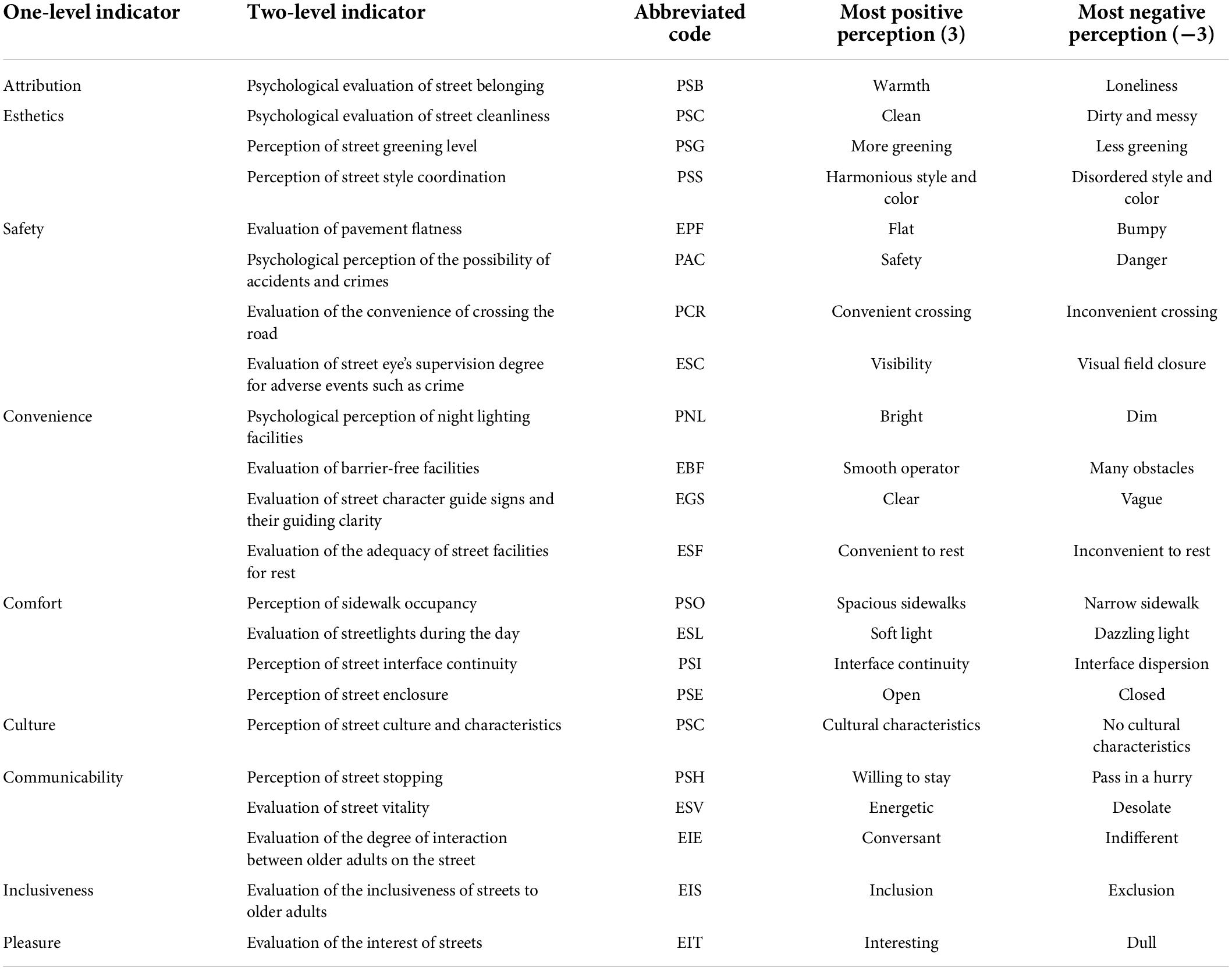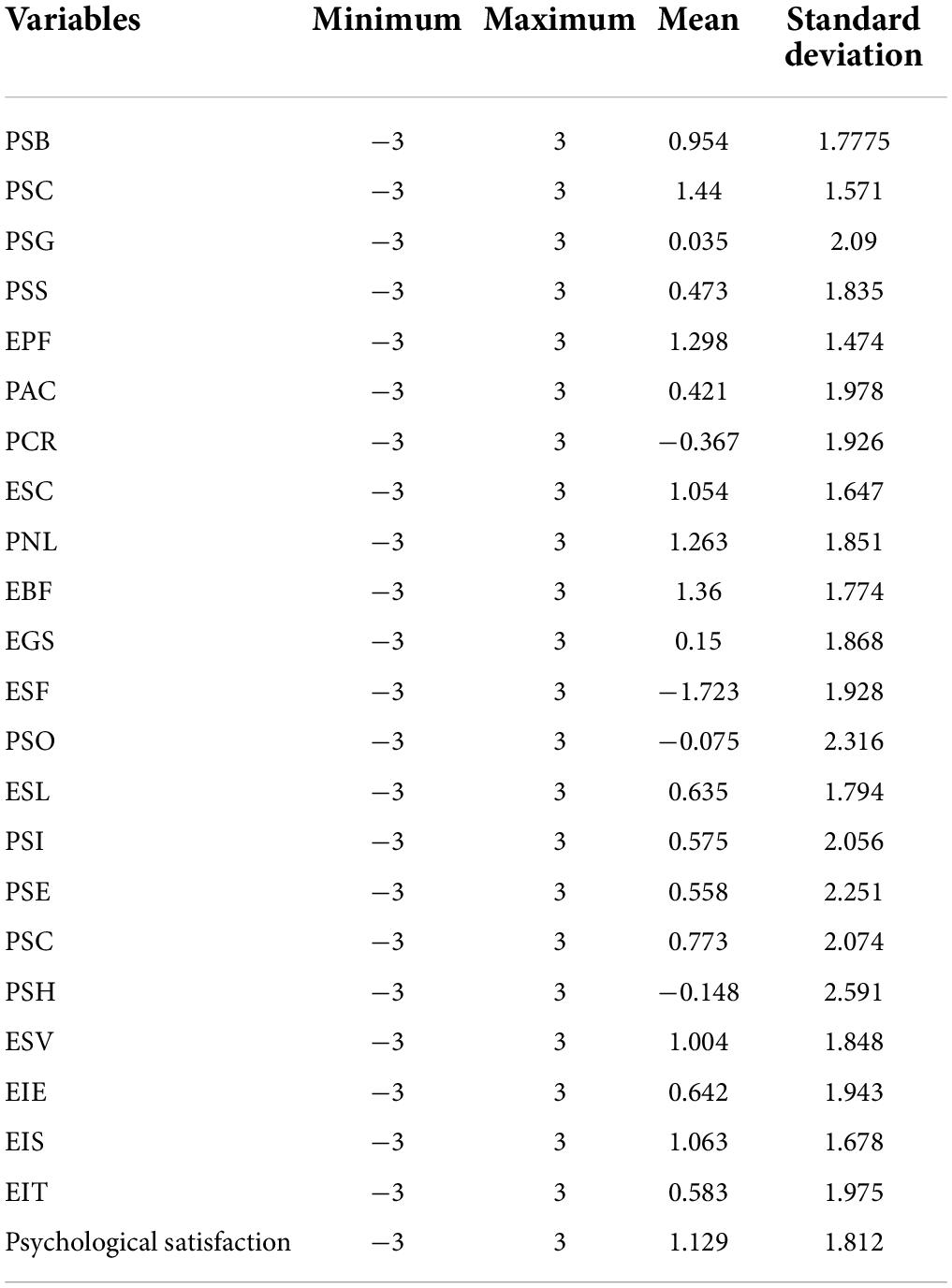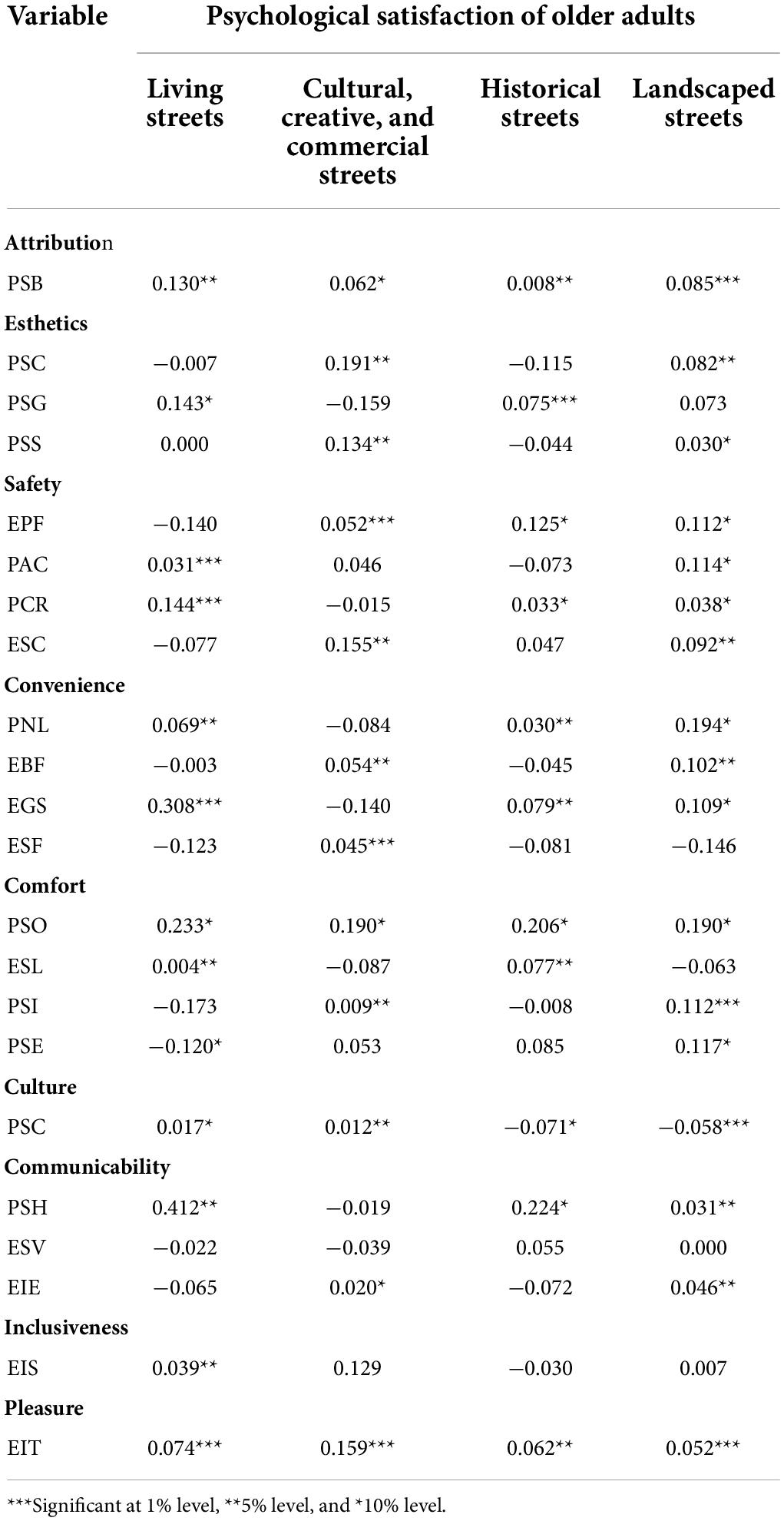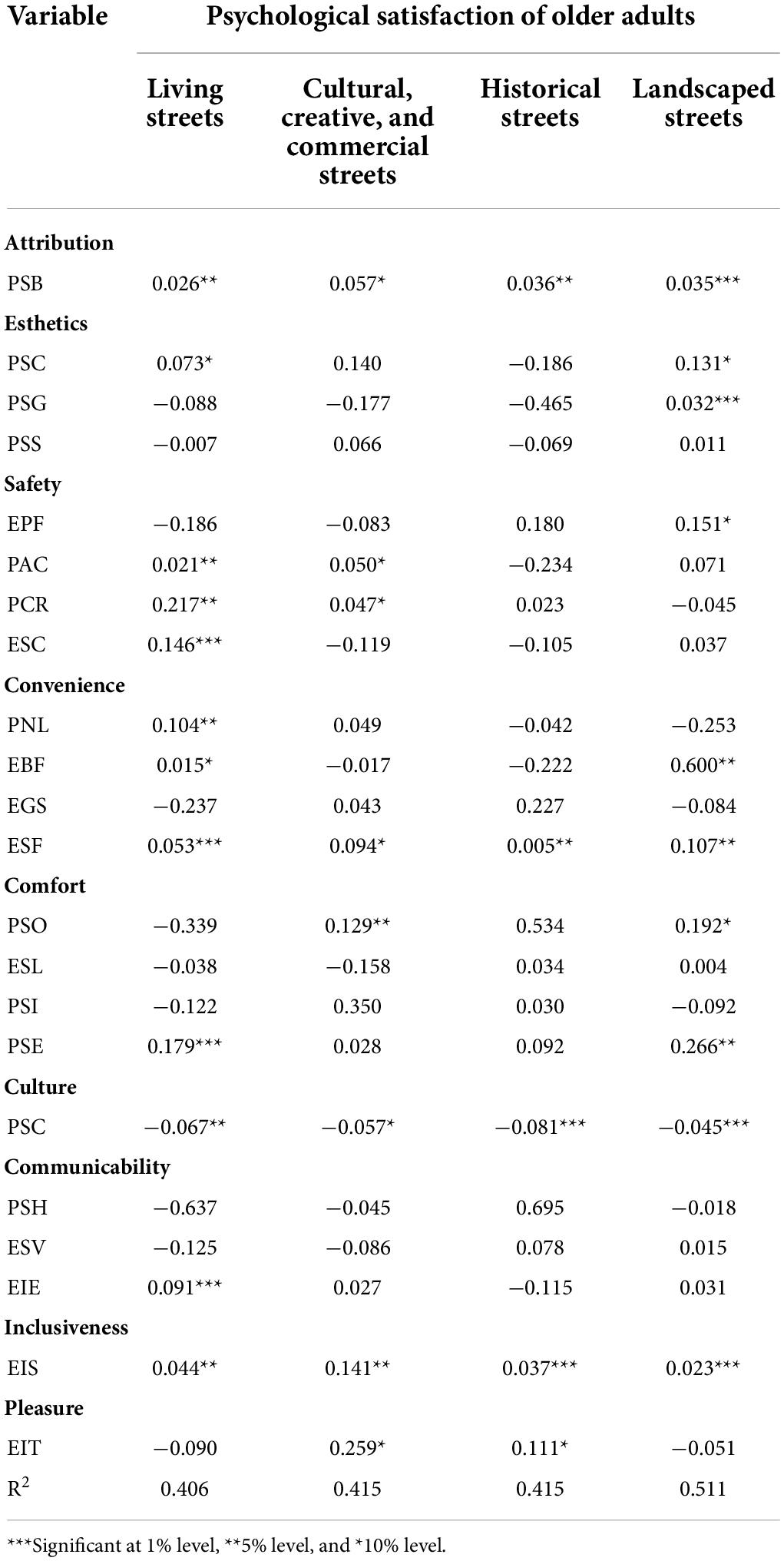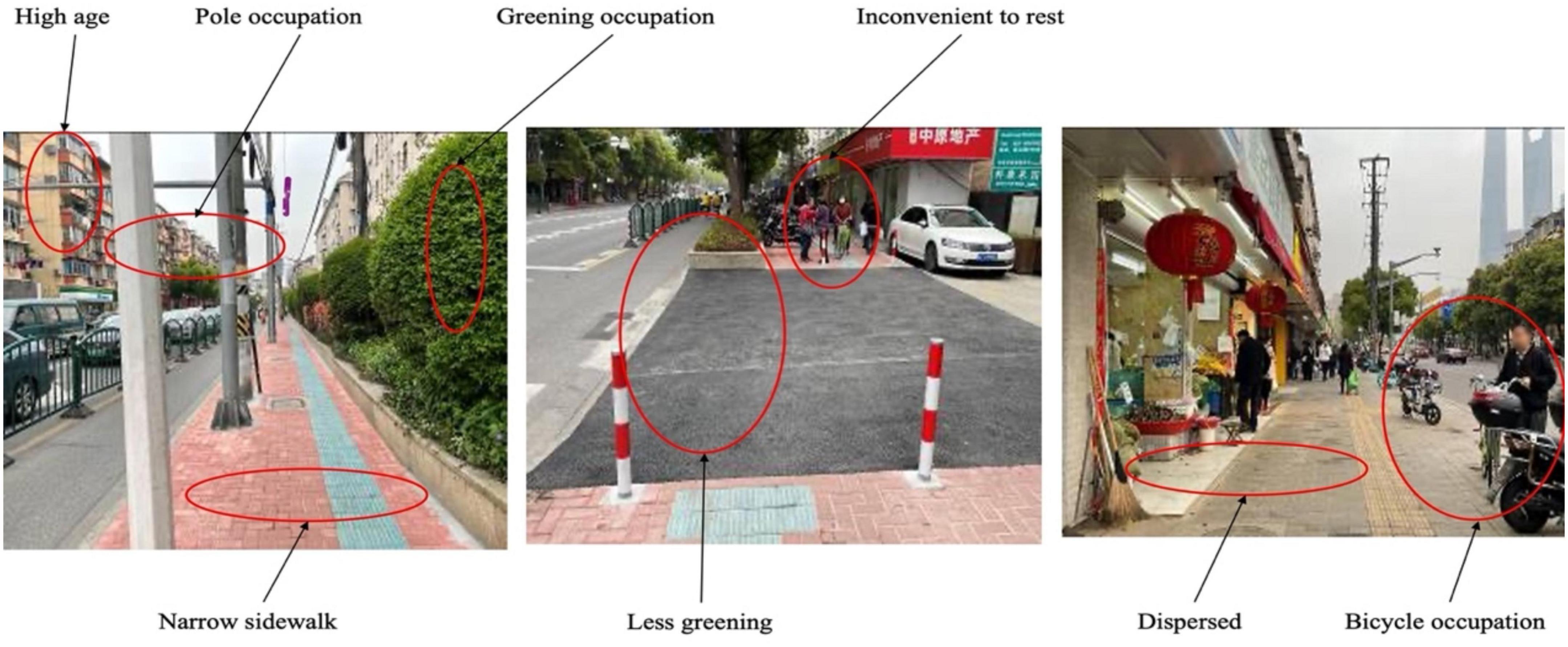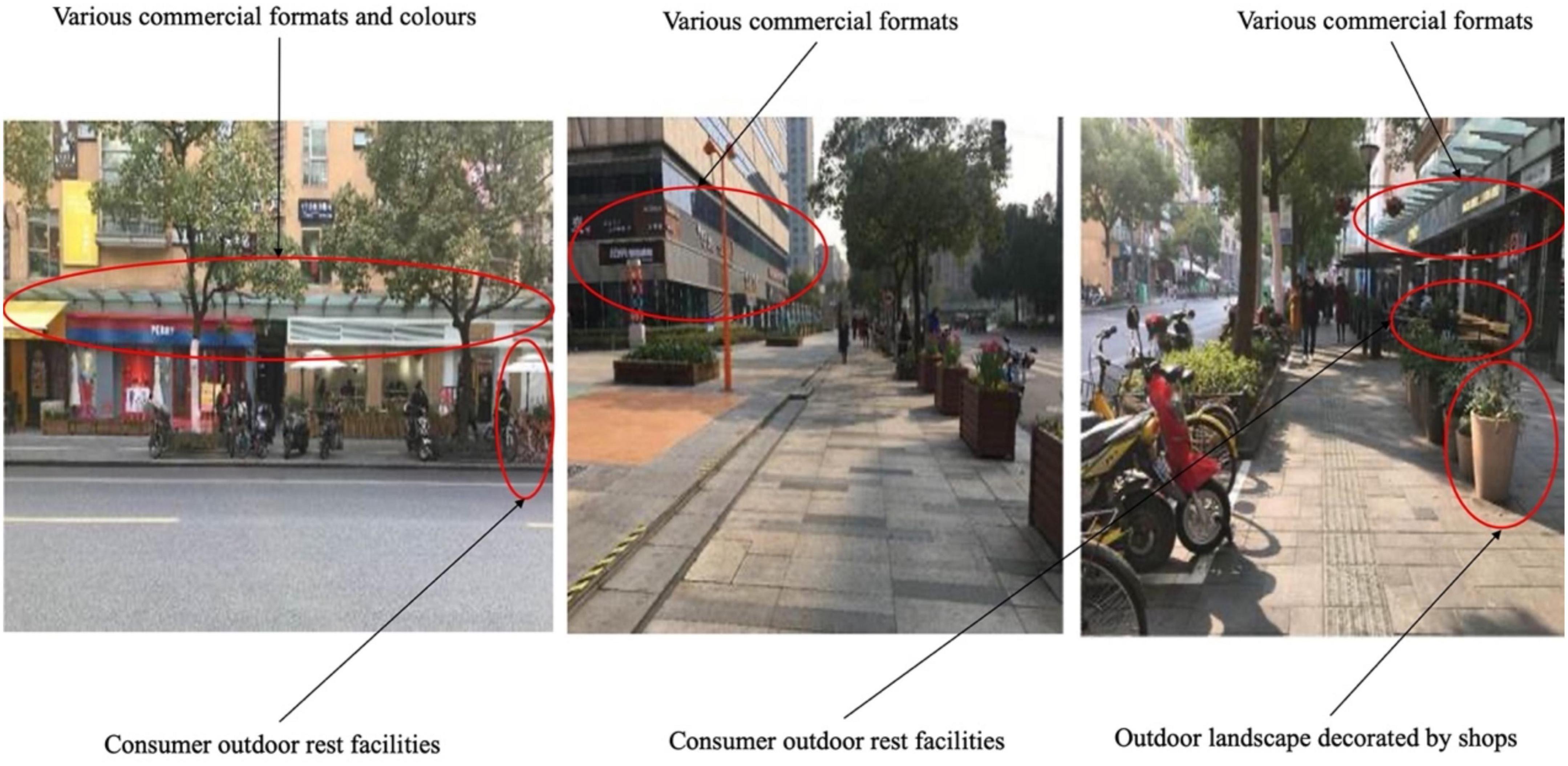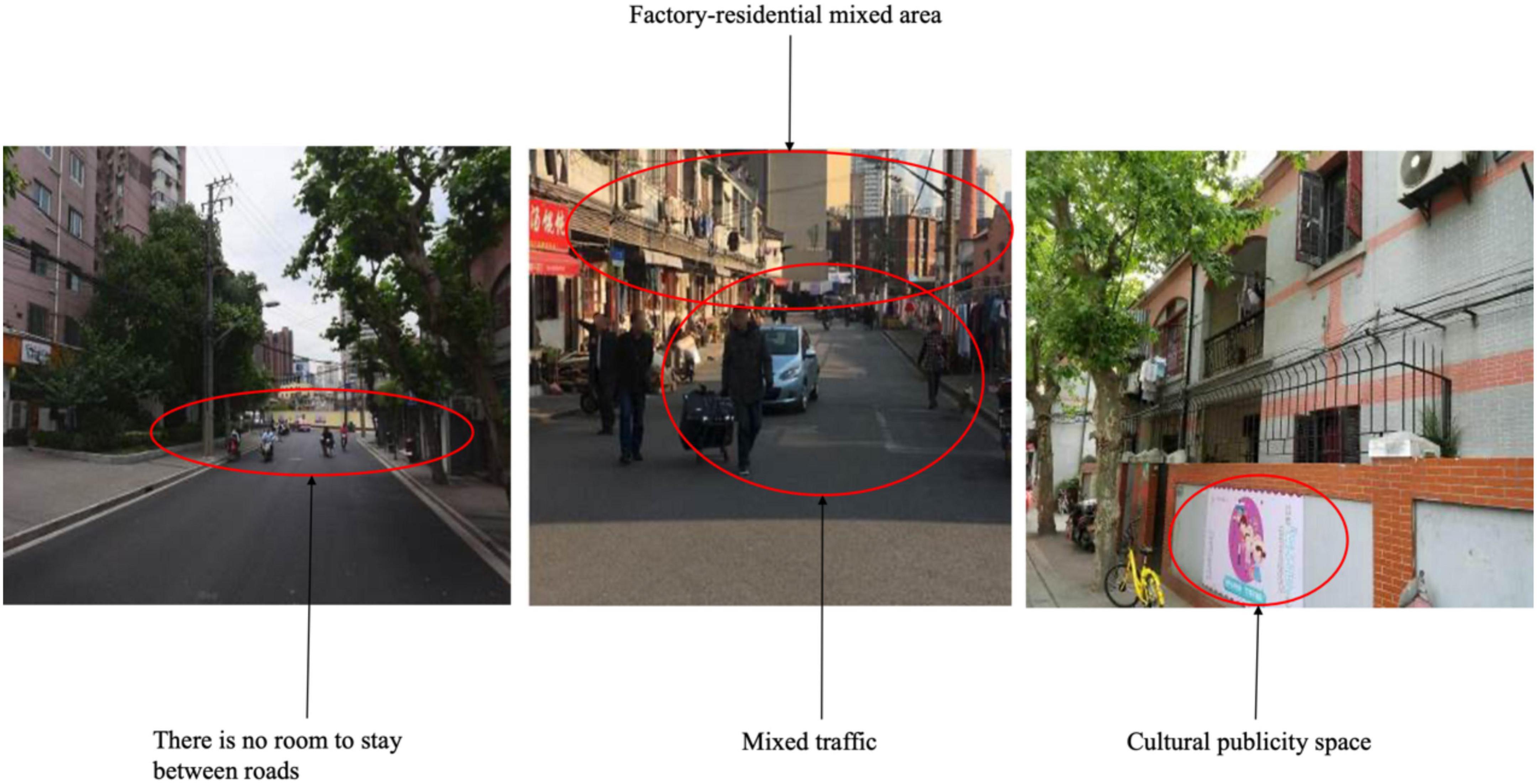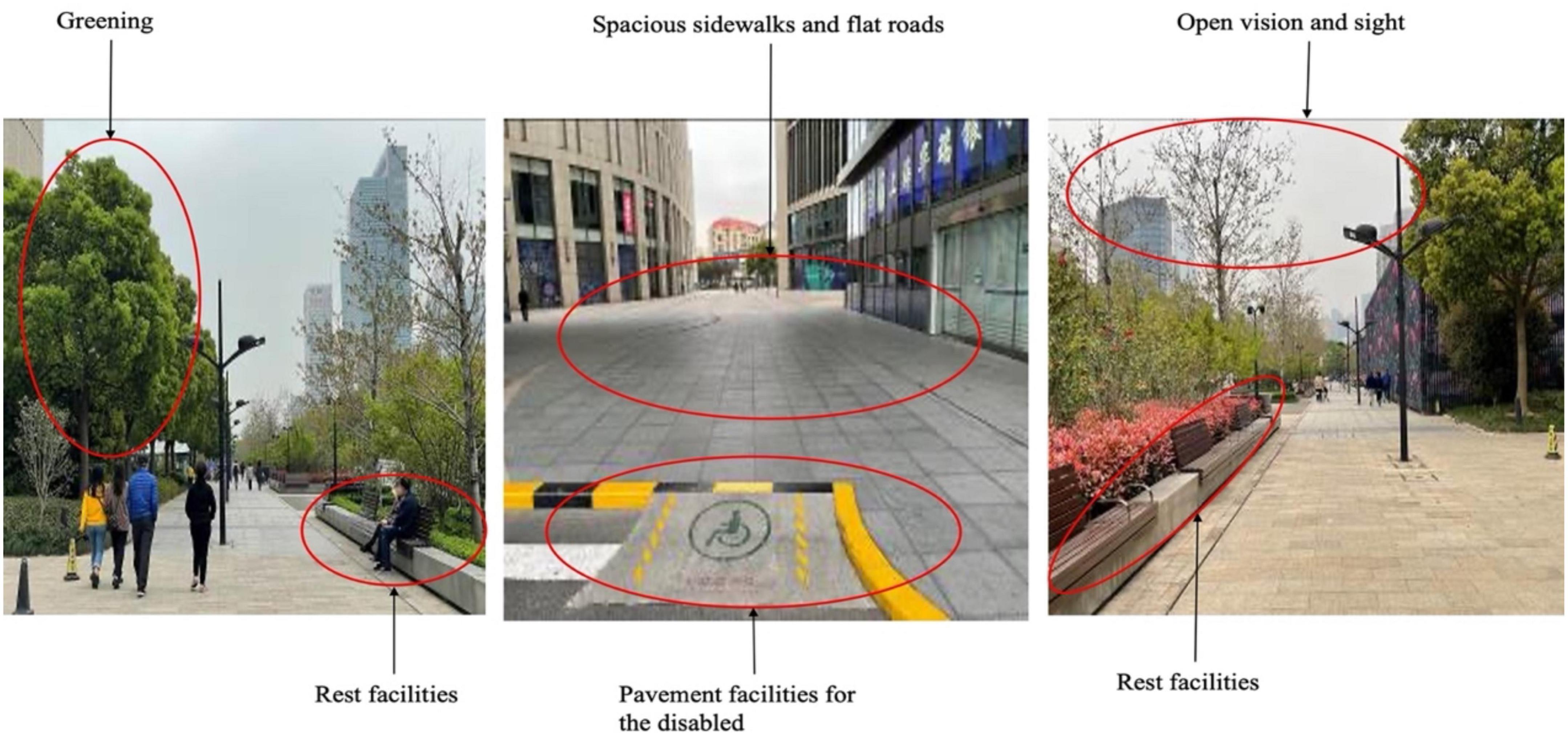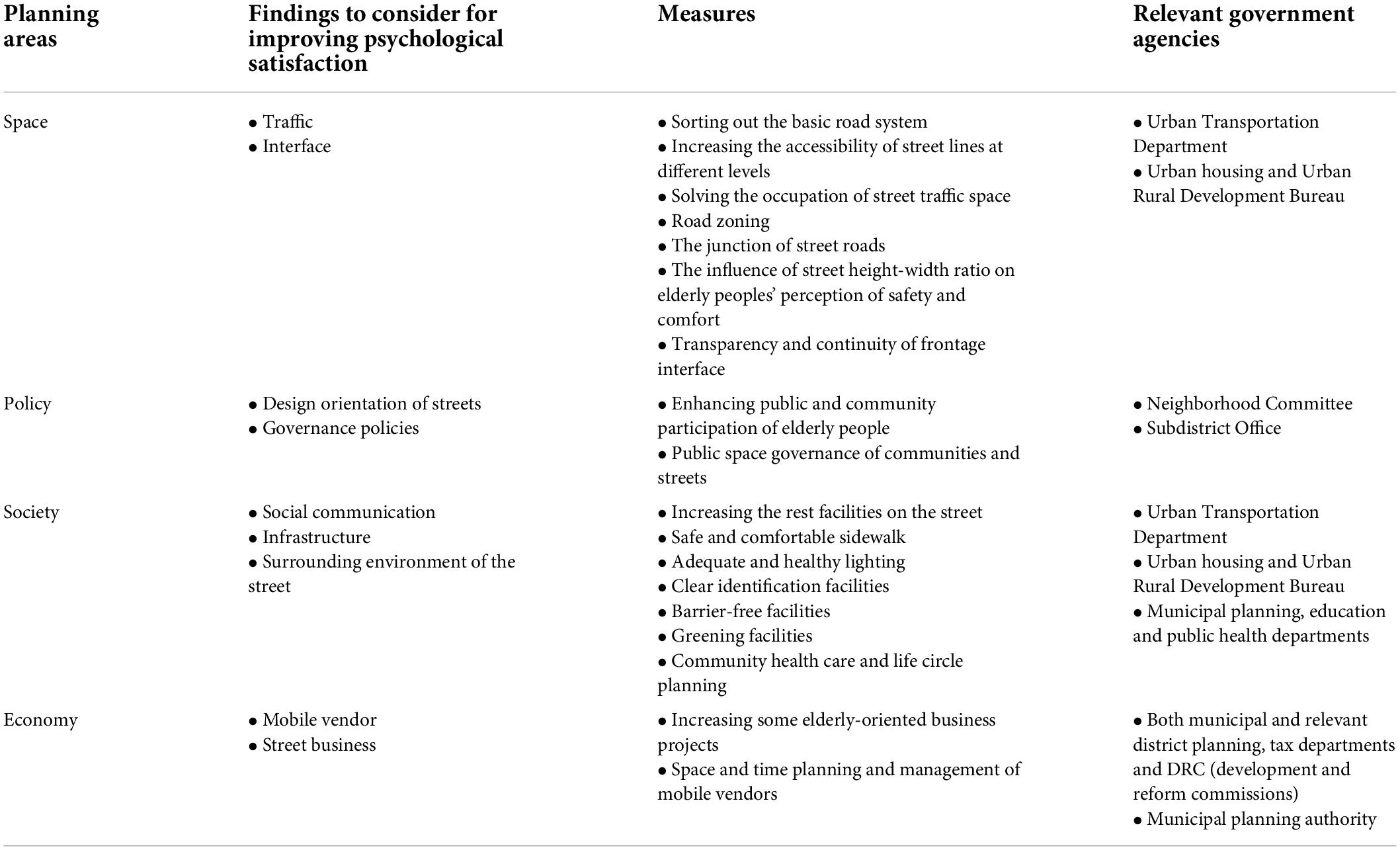- 1School of Humanities and Social Sciences, Beijing Institute of Technology, Beijing, China
- 2Beijing Institute of Technology, Beijing, China
- 3School of Management and Economics, Beijing Institute of Technology, Beijing, China
- 4School of English Language, Literature and Culture, Beijing International Studies University, Beijing, China
- 5School of Economics and Finance, Chongqing University of Technology, Chongqing, China
The psychological satisfaction of older adults is an important evaluation standard for the construction of elder-friendly cities. Meanwhile, as important space carriers carrying the travel activities and social participation of older adults, streets are also of great significance to improve psychological wellbeing. However, few studies pay attention to the street usage of aging population, especially in the context of megacities. Moreover, the previous literature rarely distinguishes the types of streets. Thus, employing a mixed approach, we investigate the relationships between street usage and psychological satisfaction for older adults. Based on the survey in Shanghai, we find that a clear role for different usage indicators in the determination of subjective psychological satisfaction of older adults. More specially, the street usage and psychological satisfaction for older adults are strongly correlated, especially for living streets. Psychological satisfaction for older adults in different types of streets is not always positively related to the positive perception of street usage. The psychological satisfaction of different streets depends on different factors. By focusing on the case of a megacity, our study emphasizes the differences between different types of streets, which will be conducive to the proposal of practical planning policies. In addition, employing mixed research methods not only explains how different street usage affects the psychological welfare of older adults on a macro scale, but also emphasizes the inner world of respondents.
Introduction
The wellbeing of aging people is an important dimension of modern city development and planning in response to increasing urbanization and the aging population (Kemperman and Timmermans, 2014; Alidoust et al., 2019). Psychological satisfaction with aspects of urban life (e.g., street usage) is an effective measure of a society’s ability to promote wellbeing and harmony. Psychological satisfaction of older adults is also widely regarded as a predictor of social inclusion because psychological satisfaction can be enhanced by increasing the mobility and independence of vulnerable groups within the built environment (Chen et al., 2019; Zhang et al., 2022). Thus, many studies have explored the wellbeing of older adults in the development process of cities and regions from the perspectives of community support and health services (Sexton and Bedford, 2016), family pressure (Santis, 2012), voluntary or paid work (Sagherian et al., 2021), and consumption and economy (Delabastita et al., 2021). Studies have all acknowledged that progress in the built environment correlates with improved psychological wellbeing for older adults.
Population aging has become a global social phenomenon in modern urban development. Results of China’s seventh census in 2020 indicated that the proportion of older adults in the population had reached 13.5%, with an increase of 4.63% from the previous census. Growth of China’s aging population is accelerating. Shanghai is a megacity with the largest proportion of older adults in China. By the end of 2020, there were 53,349 million elderly people (aged 60 and above), accounting for 36.1% of the total residential population. The number of elderly people living alone was 305,200 (Zhu et al., 2022). It is estimated that by 2035 and 2050, China’s elderly population (aged 65 and over) will reach 327 million and 393 million, respectively, accounting for 21.8 and 26.2% of the global elderly population (Ren, 2022).
An aging population has more intensive and frequent street usage interactions. However, energy and physical constraints mean older people face a higher risk of social exclusion in their street usage that can result in physical and psychological problems, ultimately reducing their quality of life. Consequently, improving the quality of street design and infrastructure for older adults has become an important policy goal of urban planning. The World Health Organization (WHO) (2002) also advocated for access to health security for the world’s aging population, including people in rural areas. In a society with an increasing proportion of older adults, there is an urgent demand for improved planning for this changing demographic and a need for increased attention to the psychological health of the aging population.
Walking accounts for the greatest absolute proportion of travel modes used by older adults (Feng, 2017). Therefore, older people have more time to come into contact with, use and experience the streets. Psychological satisfaction with street usage has been discussed in terms of three aspects—green space on the street, the improvement of street facilities and the construction of street atmosphere. From a green space perspective, trees and plants are considered a positive urban asset that can reduce negative psychological conditions (Taylor et al., 2015). Moreover, higher public green space cleanliness is associated with a lower incidence of depression (Afrad and Kawazoe, 2020). Lack of high-quality street facilities and environments may also lead to anxiety and depression, resulting in low-quality subjective perception and social psychological problems (Ellaway et al., 2009). Street atmosphere is affected by architectural environment and socio-economic status, and an appropriate street atmosphere can improve residents’ sense of local identity and belonging (Williams and Kitchen, 2012).
However, previous studies are limited in several ways. First, most studies were not undertaken in the context of megacities, which reflect rapid urbanization and the iteration of information technology. Street design and planning must be adapted to conform with these changes in contemporary society. Older adults may find it difficult to adapt to the information society. They frequently encounter obstacles in the process of street usage that can lead to feelings of loneliness and isolation. Therefore, the study of street usage and psychological satisfaction in megacities is also of great significance for small and medium-sized cities. Second, type of street was seldom indicated in previous studies. The design and use of streets vary, and older adults use different types of streets differently. It is difficult to develop practical street improvement proposals for increased psychological satisfaction of older adults if we do not distinguish between street types. Third, most studies have used quantitative statistical analysis methods. Although such approaches can reveal overall trends, they do not provide insight into individuals and previous work has not provided a deep understanding of the factors that affect individual psychological satisfaction.
Our study aimed to investigate the effects of street usage on the psychological satisfaction of older adults, using Shanghai as a case study. The wellbeing of older adults can be expressed in various forms. Our study focused on the subjective manifestation of wellbeing, that is, perceived psychological satisfaction. Based on our field work, including questionnaires and interviews, we first employed correlation analysis to clarify how street usage factors correlate with psychological satisfaction in older adults. Then, ordinary least squares (OLS) estimation was used to reveal to what extent and how different street usage factors affect the psychological satisfaction of older adults. Finally, interviews were used to focus on individual psychological satisfaction and its formation mechanism. Our study contributes to the existing knowledge in several ways. First, the megacity context may provide a valuable reference for other cities. Second, we emphasized the differences between street types, which will be conducive to the proposal of practical planning policies. Third, we implemented a mixed research strategy combining quantitative and qualitative methods. We considered that this research strategy would yield complementary insights and open the possibility of using this research paradigm in psychology and related disciplines in the future. The remainder of the paper is organized as follows. Section 2 provides a literature review. Our study area, data and methods are clarified in Section 3. Section 4 describes the results of statistical analysis and interviews, together with discussion of these aspects. Finally, we conclude by summarizing significant findings and making suggestions for future research.
Literature review
Aging-friendly cities and psychological satisfaction
In this manuscript, we refer to “cities” as a general concept that includes traditional cities and urban communities. Aging is not a simple physiological reflection but rather a complex phenomenon constructed by social and historical environments (Wahl et al., 2012). As the economic environment has changed, so the social view of aging has gradually shifted from negative to positive. Older adults have slowly moved from “being regarded as a social burden” to “an important resource for families and society” (Yuan, 2021). Therefore, the construction of age-friendly cities is gradually becoming popular and occurring all over the world. Age-friendly cities aim to meet the needs of older adults, improve service quality, and create opportunities for older people to realize their self-worth. Such approaches promote active aging and enhance the psychological wellbeing and sense of acquisition of older adults (Buffel and Phillipson, 2016). These goals are brought about by optimizing the material environment, improving the policy system, and creating an atmosphere conducive to participation. Age-friendly cities include environmental and social features (Fitzgerald and Caro, 2014; Steels, 2015). Figure 1 illustrates how age-friendly cities lead to psychological satisfaction, and the main themes that formed the focus of previous studies.
Being “space friendly” is key in terms of environment. Studies of older peoples’ satisfaction with their living environment have developed from demographic, neighborhood, and social perspectives (Bruin and Cook, 1997; Phillips et al., 2005; Rioux, 2007). Living space is often the central focus of the aging population—especially people with physical and financial limitations—and thus, understanding how living space predicts psychological satisfaction is important (Rioux and Werner, 2011). Current studies are carried out at the level of state and ethnic groups, and travel space mainly focuses on how accessibility contributes to wellbeing. Accessibility is mainly viewed as the potential for opportunities to interact (Pereira, 2019), but it also involves land use, transport, and individual and temporal aspects (Geurs and Van Wee, 2004). The most basic logic is the extent to which the interaction between land use and transportation helps elderly individuals participate in social activities at different times to improve their psychological wellbeing (Zhang et al., 2022).
In terms of public space, systematic environmental construction can be used as a balanced means to address gender differences and improve psychological satisfaction in older residential communities (Yu et al., 2021). Public space promotes the health of older adults and determines their preferences through active aging approaches, especially their use of public space in residential areas (Lak et al., 2020). Cities can create a safe and accessible material space to improve the psychological wellbeing of older adults, taking the living place as the axis, the living community as the radius, and relying on urban public facilities. Planning that considers the wellbeing of older adults can ensure a comfortable, convenient, safe and worry-free urban environment for daily life and travel.
The study considered the links between age-friendly cities and psychological satisfaction from political, social and economic perspectives. The political perspective is mainly reflected by supportive and inclusive social environments. Studies aimed to improve psychological satisfaction through pension and medical services (Chen et al., 2020; Thomas et al., 2021) because the older population relies more heavily on health facilities than other population groups in urban construction (Hudson and Nolan, 2015). Further, social security involves public finance and government budget, including medical insurance, subsidies, and legal aid for older adults (Yang et al., 2010). Studies show that an optimal social security system can improve the psychological satisfaction of older adults by ensuring their life autonomy (Hsieh, 2015; Martin et al., 2021). Human rights imply a sense of respect for older adults, including access to basic public services in a range of places and through consideration of national public policies. This respect and ease of access can relieve the anxiety and psychological distress of older adults (Fernández-Fernández et al., 2020). The social-friendly perspective leads to the social participation of older adults in volunteer organizations, associations, and sports activities.
Social participation, including the comprehensive interaction between personal health and related environmental characteristics, plays an increasingly important role in promoting the psychological health and quality of life of older adults (Xin and Li, 2021). Moreover, health has a significant regulatory effect on the psychological and social compensation mechanism of older adults’ social participation (Xin and Li, 2021). In community culture, religious participation is important in alleviating the pain of older adults with low levels of social support, and religious participation may be important in managing the psychological distress of older adults (Dulin, 2005). Other studies have considered psychological satisfaction in the national cultures (Aw et al., 2017; Tsubouchi et al., 2021). To date, most studies have explored the relationship between consumption and psychological welfare of older adults, e.g., leisure, consumption of health products and living materials (Kekäläinen et al., 2016; Boehm et al., 2018). Few studies have investigated the reemployment of older adults, an important focus because it can increase older adults’ psychological satisfaction through the embodiment of their social value.
Street space usage and psychological satisfaction
Based on research at city level, studies have focused on a smaller spatial scale: street usage (Tan, 2014; Carmona, 2019). Figure 2 demonstrates the relationships between street space usage and psychological satisfaction for older adults based on existing studies.
Streets represent the vitality of a city. A vibrant street should not provide a single traffic function but rather a combination of uses. Street space design should be people-oriented and pay attention to the needs of street users. Good street space design can enhance people’s travel and wellbeing. Studies of street usage have shifted from paying attention to a single demand for safety or belonging to more complex needs. For example, the safety and attractiveness of streets are important for increasing residents’ outdoor activities and perceived satisfaction (Rahm et al., 2020). In addition, improving the spatial planning of streets, such as spatial accessibility, green space, landscape configuration, and public facilities, can significantly improve the mental health of residents (Jeong et al., 2022; Kumar and Shukla, 2022; Zhang et al., 2022). Some studies have even discussed the relationship between street space use and high obesity rates (Zhao et al., 2018; Poulain et al., 2020).
Safety is the premise and foundation of all activities and is a key factor in determining older adults’ willingness to use the street. Many street safety theories and achievements relate to traffic vehicle and environmental safety, with traffic safety being a necessary condition for older adults to walk (Zhang et al., 2022). Safety involves the physical environment of the street, such as street materials and flat surfaces. Convenience mainly refers to the ease with which the street’s own facilities are used. Essentially, convenience leads to street users carrying out activities in the street and promotes the use and evaluation of street space (Landau, 2018). Physical and psychological comfort refers to the sense of comfort and tactile awareness of street use (Rodríguez Algeciras et al., 2016).
A good physical environment can provide users with a better street space experience. Street space provides the most basic transportation function in a city and is also the most important public activity space. It enables residents’ daily activities, such as social communication, and gives rise to primary impressions of a city. Dull streets may suggest that a city has little to offer, while vibrant streets remind people of the city’s vitality (Li et al., 2021). The vitality value of a street also reflects the street’s communicability (Xia et al., 2020). A lively street can promote older adults’ social interaction and help reduce loneliness. Esthetics is the psychological feeling brought about by street users’ perceptions of the visual level of the environment (natural environment and construction environment) (Southon et al., 2017). The natural environment includes street greening and planting, while the construction environment comprises street style, color, and cleanliness. Belonging in elder-friendly streets is a spiritual feeling regarding sense of identity, belonging, familiarity and the feeling of warmth and being “at home” (Smets and Sneep, 2017).
Older adults may take pleasure in elder-friendly streets that are attractive and appealing. Such streets contrast with a monotonous street atmosphere, yielding a positive subjective psychological perception of the street space and its diverse social activities (Kang et al., 2021). Culture emphasizes that the elements of street space can represent its historicity, story or unique regional characteristics (Ross, 2021) that can arouse the cultural identity and memory cognition of older adults. However, few studies have explored the psychological perception of street culture among older adults. Inclusiveness is a measure in a more general sense. It shows that street space design is conducive to the harmonious coexistence of groups of different ages, occupations, and educational levels. Inclusive street spaces are friendly and inclusive of the activities and exchanges of older adults, children, women, and other vulnerable social groups. In such spaces, older adults have a sense of identity and acceptance and are willing to socialize with others.
Methodology
We examined how perceived characteristics of street usage influence psychological satisfaction of older adults across the streets of Shanghai. The theoretical framework that motivated the study was based on the multiple values of elder-friendly streets and the demands of older adults on streets. Although theoretical links between street planning and psychological satisfaction have been well-investigated, aging has not been taken into account, especially in metropolitan areas with extremely active economies. Thus, the study sought evidence of relationships between street usage and psychological satisfaction of older adults in the context of megacities.
Case study
In light of the importance of case selection, a Chinese megacity was chosen to highlight street usage and psychological satisfaction issues in a context of rapid aging population growth. Megacities are important for several reasons. First, the cost of aging is gradually becoming unaffordable in megacities. Therefore, the choice of a megacity has practical significance for providing timely policy implications for policymakers and planners in megacities on how to refine the governance and planning regime to improve psychological satisfaction. Second, lessons and experiences from a megacity may be relevant for other growing cities although megacities are relatively unique regarding social development. Megacities are like other municipalities in terms of rapid urbanization and aging population expansion, with their governing and planning authorities and pro-growth initiatives. Furthermore, growing cities may face similar population control issues. The challenges faced by megacities in the past may confront other municipalities in future. Indeed, recent years have seen a substantial increase in aging society in other cities. Third, the large and diversified population and cultural structure of megacities are conducive to the establishment of sound infrastructure and public service rules, helping to form an age-friendly street usage and governance system. This complex process may provide a useful reference for other types of cities.
Shanghai was chosen as our case study (Figure 3) because it provides a typical example of a world megacity that faces a serious aging issue (Zhu et al., 2022). Shanghai consists of 16 districts, and we selected four typical streets, all located in districts with a high proportion of older people. These streets were Rushan Road, Daxue Road, Hailun Road, and Century Avenue. Although older people may experience mobility difficulties, they have to adapt to the rapid socio-economic development of megacities. However, the psychological welfare of older adults in the built environment, especially their use of streets, has rarely been studied. While older adults play little role in the urban economy or construction, paying attention to their subjective welfare remains an important focus of urban planning and social psychology research. Furthermore, paying attention to the mental health of older adults in the process of environmental change will help build a full age-friendly city and maintain social stability. Such cities will also improve all residents’ sense of security.
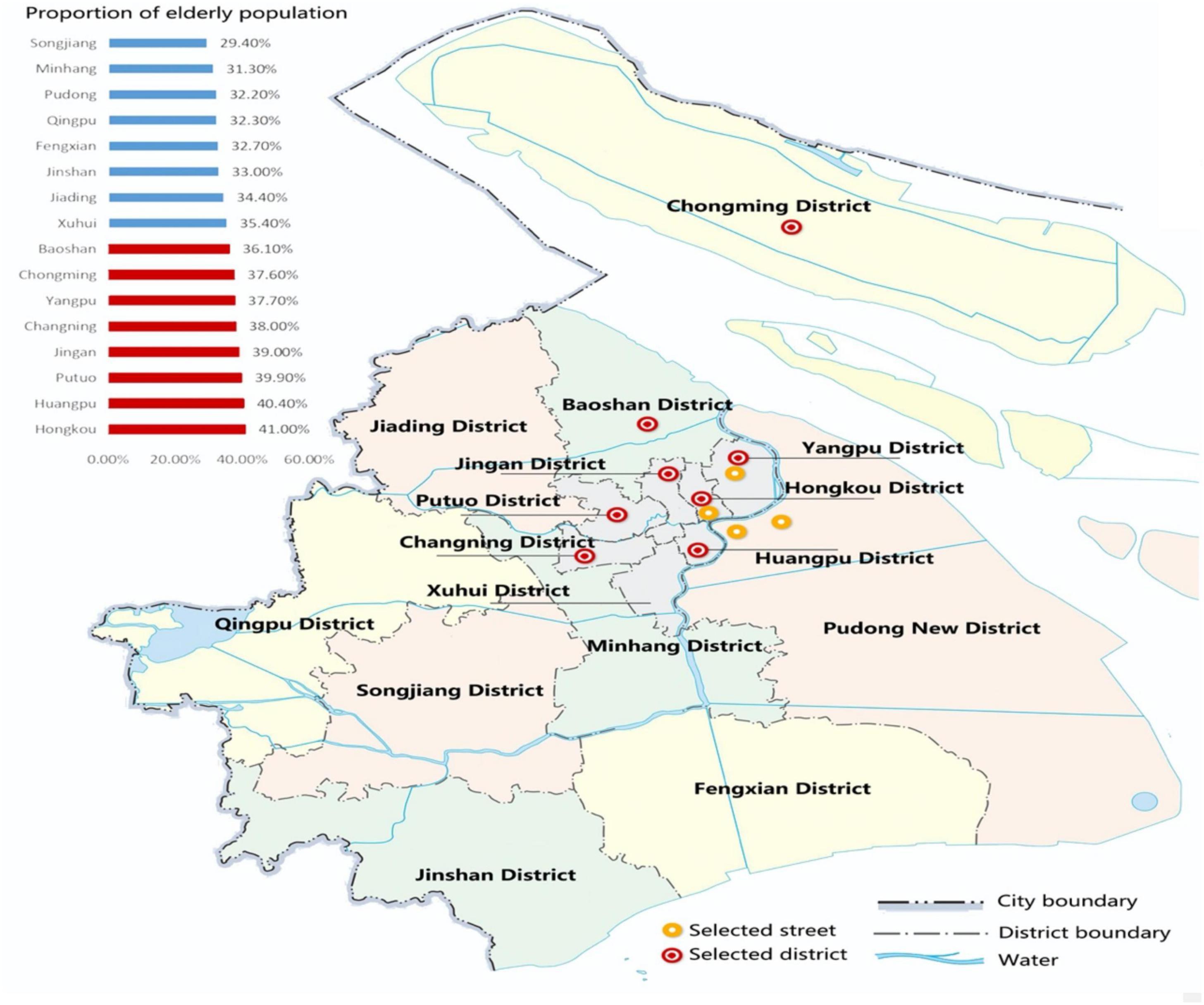
Figure 3. Study area and basic geographical and demographic information [Source: Zhu et al. (2022)].
The four streets selected in this study represent different street types, including living streets, cultural, creative and commercial streets, historical streets and landscaped streets. Rushan Road is a living street, surrounded by a large number of old communities built in the 1980s. It conveys a rich flavor of life with many real estate trading shops, fruit and vegetable shops, and other shops to meet daily needs. The shops are typically full of elderly people, many of whom are resting. In contrast, Daxue Road is a cultural, creative and commercial street. It is surrounded by residential housing, science and technology parks, and universities. There are many state-of-the-art modern public spaces on this street, but few elderly people stay or rest in these spaces. Hailun Road is a historical street built in 1908, with a rich history and culture. It is surrounded by residential communities and there are many elderly people on the street. Typically, older adults have specific street requirements. However, Hailun Road has few information guide signs; the sidewalk design lacks consideration of accessibility; there are few service facilities, such as rest seats, and there are no garbage cans on either side of the street. Finally, Century Avenue represents landscaped streets. It is a famous landscaped avenue built by the Shanghai municipal government and connecting the two landscaped areas of the Oriental Pearl TV Tower and the Century Park. It has public activity space for people to walk and enjoy their leisure or activities. The street was planned to maximize a comfortable walking experience. However, few elderly people linger on this street. Our study will distinguish the psychological satisfaction of older adults with these four street types.
Data specification and variables
Our data were derived from a large-scale psychological satisfaction survey on street usage conducted by the authors. The design of our survey relied on the residential satisfaction survey implemented in Beijing in 2005, and the perceived psychological satisfaction with the prioritized information (Gao et al., 2021). Data collection was based on a questionnaire survey that took place in the four streets. The aim was to investigate older adults’ perceived psychological satisfaction with street usage. Considering the living habits of older adults and to increase the probability of obtaining an adequate sample, we only distributed the questionnaire on weekends, and at specific time periods, i.e., 7–10 a.m. and 2–5 p.m. To ensure balanced sampling, each street was assigned 120 questionnaires, and thus, we distributed a total of 480 questionnaires. To improve the validity of the questionnaire and the quality of data, we conducted a face-to-face questionnaire survey for each respondent. We were, thus, able to respond immediately and provide face-to-face explanations when elderly people had questions about the survey. The entire survey process lasted 4 months and we collected 471 valid questionnaires, with an effective rate of 98.1%.
This study mainly considered subjective perceptions and psychological evaluation of older adults on street usage. Variables were measured using subjective perception scores derived from the questionnaire based on the subjective evaluation of the respondents. To ensure a neutral evaluation point and make the descriptions more accurate, we selected an evaluation scale with 7 points, ranging from −3 to 3. The median value of 0 represents neutral perception. A positive value indicates positive perception, while a negative value indicates a negative view.
The dependent variable in the study was psychological satisfaction of older adults. The outcomes of psychological satisfaction were quantified by asking, “In the process of using the street, do you think the current design of the street satisfies you or makes you feel psychologically comfortable?” This type of measure of satisfaction is a vital tool for psychological growth and welfare in existing studies (Ryan and Deci, 2000; Zheng et al., 2022). In this study, psychological satisfaction refers to a measure of older adults’ overall satisfaction with street design.
Our independent variables comprised nine dimensions: attribution, esthetics, safety, convenience, comfort, culture, communicability, inclusiveness, and pleasure (Table 1). Attribution measured the psychological evaluation of older adults on their sense of belonging in the streets, ranging from “warmth” to “loneliness.” Esthetics included three aspects: environment, greening, and overall design. Environment refers to the psychological evaluation of street cleanliness ranging from “clean” to “dirty.” Greening is the perception and evaluation of street greening level, measured in terms of “more greening” to “less greening.” The overall design is a perceptual evaluation of the coordination of street features, ranging from “coordination” to “clutter.” Security consisted of four indicators. The first was the evaluation of road roughness, ranging from “flat” to “bumpy.” Second was the psychological evaluation of the possibility of accidental crime, ranging from “safety” to “danger.” Third was the evaluation of road safety, ranging from “convenient” to “inconvenient.” The last was the evaluation of the degree of street eye supervision over adverse events such as crime, ranging from “transparent” to “closed” vision.
Four indicators were selected to measure the perception of convenience of street use for older adults. First was the evaluation of night lighting facilities, which ranged from “bright” to “dark.” Second was the evaluation of the interference of obstacles with facilities, described from “unimpeded” to “full of obstacles.” Third was evaluation of the street text used in guide signs and its guiding clarity, ranging from “clear” to “fuzzy.” Fourth was evaluation of whether the facilities available for resting in the street are sufficient, ranging from “convenient” to “inconvenient” for resting.
Perception of street comfort also comprised four indicators. The first was the perception of sidewalk occupation, ranging from “spacious” to “narrow” sidewalks. The second was the evaluation of streetlights during the day, ranging from “soft” to “dazzling.” Third was the perception of street interface continuity, from “interface continuity” to “interface dispersion.” The fourth was perception of the sense of street enclosure, from “open” to “closed.” Culture refers to the perception of street culture and characteristics, ranging from “cultural” to “non-cultural” characteristics.
Communicability mainly measures the social attributes of streets and consists of three indicators. The first is the perception of street staying. The most positive evaluation was “willingness to stay,” while the most negative was “pass in a hurry.” The second is the evaluation of street vitality, which ranged from “vitality” to “desolation.” Finally, it evaluates the degree of interaction between older adults on the street. The most positive evaluation was “familiarity” while the most negative was “indifference.” Inclusiveness assesses how inclusive streets are for older adults, ranging from “inclusive” to “exclusive.” Lastly, the evaluation of street pleasure ranged from “interesting” to “boring.”
Methods
This work lies at the intersection of social psychology and urban geography, and thus several methods were combined in keeping with the interdisciplinary approach. Quantitative methods included correlation analysis and Ordinary Least Squares (OLS) estimation, and qualitative methods involved semi-structured interviews. First, we computed the correlation coefficient for street usage and psychological satisfaction in older adults because psychological satisfaction can be regarded as a predictor of input in street usage and design. Thus, the degree of psychological satisfaction may directly influence street planning. Second, we employed OLS to explore the basic effects of street usage on psychological satisfaction of older adults. The OLS model specification was as follows:
Where, psychologicalsatisfactioni is the psychological satisfaction for the older adult i; streetusage denotes a set of k independent variables, and the maximum value of k is 22. εi is the error term.
However, the results of OLS estimation are relatively weak in meeting our aim of testing the impact of street usage on psychological satisfaction because OLS regression may suffer from potential issues of biased estimation (Gao, 2021). Consequently, third, the study used semi-structured interviews to investigate how street usage affects the psychological satisfaction of older adults. The qualitative approach supplemented the quantitative methods, with qualitative interviews focusing on respondents’ views and exploration of events they consider relevant and important (Wang and Kulich, 2015). Researchers could flexibly adjust the interview questions, change the strategy and wording of questions, and even ask new questions (Clegg and Stevenson, 2013). Therefore, this approach helped us understand the study results more deeply.
Results
Correlation analysis
Table 2 shows the results of descriptive statistics concerning all variables. Table 3 indicates the results of correlation coefficients between street usage and psychological satisfaction. Table 2 indicates that street usage and the psychological satisfaction of older adults were strongly correlated, especially for living streets. Attribution was more strongly correlated with living and landscaped streets. Esthetics was more relevant to cultural, creative, and commercial streets and historical streets. In contrast, older adults have relatively low requirements for the safety of historical streets, possibly because of their low frequency of use of this type of street.
Increasing convenience can greatly improve the psychological satisfaction of older adults in living streets and cultural, creative and commercial streets, as indicated by the strong significance. Psychological satisfaction, particularly in living and landscaped streets, is positively related to comfort, whereas the other two streets have relatively low requirements for comfort. In terms of culture, the correlation results are interesting. Reduction in perception of street stopping (PSH) is significantly correlated with psychological satisfaction for older adults in historical and landscaped streets. One possible explanation is that high cultural connotation will increase the psychological burden of older adults and reduce their understanding of the streets in the process of street usage. Overall, although there is a significant correlation between communicability and psychological satisfaction, the degree of correlation was not strong. This may be because of the recent development and popularity of gated communities. In addition to living streets, inclusiveness was not significantly correlated with psychological satisfaction in other types of streets. In contrast, the increase in pleasure was significantly associated with psychological satisfaction of older adults in all types of streets.
Ordinary least squares estimation results
Table 4 reports the OLS results on street usage impacting psychological satisfaction of older adults, based on street types. Contrary to our expectations, psychological satisfaction of older adults in different types of streets was not always positively related to the positive perception of street usage. Psychological evaluation of street belonging (PSB) was used to show attribution and had a positive effect on psychological satisfaction in all streets. The results indicate that positive attribution correlates significantly with high psychological satisfaction because a strong sense of belonging can bring feelings of familiarity and security, and lead to a relaxed mood (Harvey and Martinko, 2009; Burger et al., 2015). Esthetics had significant positive effects on living and landscaped streets, but its impact on cultural, creative and commercial streets, and historical streets was insignificant. In particular, the positive influence of PSB on living streets means that a clean-living environment can increase the psychological satisfaction of older adults.
For landscaped streets, the positive effects of greening (perception of street greening level, PSG) were the most significant. These results have been widely discussed in literature that focuses on the relationships between green spaces and individuals’ psychological wellbeing (Qiao et al., 2021; Jiang and Huang, 2022). Living streets present significant demands for safety. In contrast, for older adults, the safety of historical streets has little to do with their psychological satisfaction. In cultural, creative and commercial streets, older adults are more concerned about accident crime and road safety because of the significance of psychological perception of the possibility of accidents and crimes (PAC) and evaluation of the convenience of crossing the road (PCR). In landscaped streets, flat pavements can significantly improve the psychological satisfaction of older adults. The convenience indicator of whether streets provide enough rest facilities can lead to significant change in older adults’ psychological satisfaction, and is determined by their physical function. In addition, in living streets, the improvement of night lighting facilities and fewer road obstacles can significantly increase older adults’ psychological satisfaction. Some variables in commercial streets were not significantly impacted because older adults rarely participate in commercial street activities. A similar situation exists on historical streets. Participants noted that even if they got lost, they would not look for signs but rather ask the people around them for help. Older adults reported rarely choosing to travel at night and, thus, the variable of psychological perception of night lighting facilities (PNL) was not significant in any street type.
At comfort level, the reality of tight land use in megacities means that open space and vision can lead to high psychological satisfaction in living streets. In cultural, creative and commercial streets, spacious sidewalks have a significant positive impact on the psychological satisfaction of older adults. High comfort does not necessarily increase psychological satisfaction with historical streets. To some extent, this reflects the limited interaction between older adults and historical streets. For landscaped streets, spacious sidewalks and wide horizons can increase psychological satisfaction. Culture has significant negative effects on the psychological satisfaction of older adults in all kinds of streets. Culture is not a pressing need for older adults using the streets (Hofer et al., 2016) and even a high cultural connotation will hinder older adults’ understanding and use of streets. Therefore, this negative impact suggests that street planners should consider the public’s acceptance of culture.
Living streets demand communicability, which has a significant positive impact on the psychological satisfaction of older adults. This result shows that having more familiar people on the streets leads to greater psychological satisfaction when using the streets. However, this significant impact only occurs in living streets. For other types of streets, communicability has no significant impact on psychological satisfaction. One possible reason is that older adults use these streets for a short time and seldom undertake social activities on these streets (Zhang et al., 2021). High inclusiveness levels were linked to high psychological satisfaction. Many elderly people find it difficult to accept modern information technology in the context of rapid economic development and the progress of smart megacities. They may experience negative psychosocial impacts of isolation (Östlund et al., 2015). Thus, when their needs are taken into account in the design or planning of streets, their psychological satisfaction will increase. Pleasure in cultural, creative and commercial streets and historical streets can lead to increased psychological satisfaction, although the effects of pleasure in living and landscaped streets were not significant.
Interviews: How does street usage affect the psychological satisfaction of older adults?
Using interviews, we sought to understand more deeply how the factors in the questionnaire affect the psychological satisfaction of older adults. Results of OLS regression indicated that the psychological satisfaction of older adults was quite different for the four types of streets and each street had different characteristics. Overall, the factors had a more significant impact on living and landscaped streets, and general psychological satisfaction with historical streets was relatively low. These findings are consistent with the principle and original intention of our study design: diversified street models and environments are conducive to the design of street space suitable for older adults, and improving the psychological welfare of this population may lead to more all-age friendly cities. Interview results are presented in Table 5, showing the factors influencing the psychological satisfaction of older adults based on the indicators in the questionnaire.
Rushan Road is a living street in an old community in Shanghai where houses were built many decades ago. Most of the commercial activities on both sides of the street are closely related to residents’ daily lives, and most of the street users are older adults living in the community. Evaluation of the street included: (1) It is convenient to cross the street; (2) The line of sight is clear and the street is energetic; (3) Older adults are relatively familiar with shopkeepers and street pedestrians; and (4) The street is inclusive of older adults. However, there are also many deficiencies, mainly linked to the relatively old street construction. These included narrow sidewalks and road occupation by bicycles, telegraph poles and greening (Figure 4). Older adults expressed their dissatisfaction with aspects such as limited greening, few convenient resting places; discrete nature of the greening and pavement design, and inconvenient for walking. It is almost impossible to walk on the sidewalk if a person in a wheelchair is already using it. Other pedestrians then have to walk on the roadway, deepening insecurities about walking. Therefore, older adults are unwilling to stay on this street and limit their interactions to buying necessities and walking only when necessary in the area. On the whole, psychological satisfaction with Rushan Road is relatively low.
Daxue Road is a cultural, creative and commercial street near Fudan University and Shanghai University of Finance and Economics. Both sides of this student street exhibit cultural and creative office land and residential buildings. Although most of the street users are young people, many elderly people walk among them. As shown in Figure 5, the businesses on both sides of the street are diverse, and many of the older people interviewed on this street noted that the lights are bright at night, and the commercial formats and store design have specific cultural characteristics that give them great pleasure. Shops are painted in different colors to show their personality, creating an impression of chaotic street style and color. Although the street is equipped with many rest and landscape facilities, most of them are part of shops and mainly for customers. Thus, older adults considered these facilities inconvenient places to rest and felt they were not generally inclusive.
In terms of historical streets, Hailun Road has a long history and rich culture. There are traditional mixed areas of factories and houses along the street and a former residence of calligrapher Shen Yinmo. The older adults interviewed on this section of the street referenced the area’s rich cultural characteristics. However, the streets have not been widened and the sidewalks are narrow with little greening. Pedestrians must sometimes walk in the carriageway—a situation even more inconvenient for older adults with mobility problems who need to use wheelchairs. The mixed traffic of people and vehicles on the high street complicated older adults’ psychological evaluation in terms of risk index and unsafe road crossing. Participants commented that the street is inconvenient for resting and there is little room to stop and chat (Figure 6). They must pass in a hurry in the street. Therefore, their perception of this street is relatively cold and boring, and the street has little attraction for older adults.
Century Avenue is a landscaped urban avenue. Older adults were more positive about their psychological satisfaction of this space. Perceived impressions included open vision, clean streets, more greening, flat roads, transparent lines of sight, barrier-free facilities, clear street signs, unobstructed roads, convenient resting facilities, spacious sidewalks, clear division of people and vehicles, and bright night lighting (Figure 7). Walking on this street, they have a strong sense of security. The interviewees said they were willing to stay, talk and rest on the street. However, the landscaped avenue was also rated relatively low in overall psychological satisfaction. The wide street is difficult to cross and familiarity between pedestrians on the street is relatively low, leading to a limited sense of belonging and individuals not feeling at home on the street.
Conclusion
The study aimed to evaluate the empirical evidence of street usage to account for older adults’ psychological satisfaction with different types of streets in Shanghai, China. Overall, our results demonstrate a clear role for usage indicators in determining subjective psychological satisfaction of older adults. Specifically, our study was conducted in the context of a megacity with rapid urbanization and a move to becoming a smart city. Knowing how older adults adapt to this intelligent society and street life is important for understanding their psychological satisfaction. Street segmentation was also an important contribution of this study. Using different types of streets, we explored the impact of street usage on psychological satisfaction, providing more detailed and feasible policy suggestions for the planning of streets. The mixed research methods explained how street usage affects the psychological wellbeing of older adults on a macro scale, and also enabled deep exploration of respondents’ inner worlds. In particular, the qualitative interviews showed the important role of interpretivism in psychological research.
Our study led to several conclusions. First, street usage and psychological satisfaction of older adults are strongly correlated, especially for living streets. This is because older adults use living streets the most, and thus, the intersection between older adults and living streets is great. Second, psychological satisfaction of older adults in different types of streets is not always positively related to their positive perception of street usage. In particular, culture was negatively correlated with older adults’ psychological satisfaction in historical and landscaped streets. This may be because older adults cannot fully understand the connotation of street culture in the process of street usage, leading them to feel isolated from society and increasing the risk of anxiety and depression. Third, the interview results indicated that in living streets, attribution, safety and inclusiveness lead to high psychological satisfaction, while esthetics, convenience, comfort, sociability, low pleasure, and culture lead to reduced psychological satisfaction. In terms of cultural, creative and commercial streets, pleasure and culture can bring high psychological satisfaction, whereas convenience, esthetics, and inclusiveness lead to low psychological satisfaction. In historical streets, increased culture improves the psychological satisfaction of older adults, while low safety, esthetics, convenience, comfort, communicability, and interest reduce psychological satisfaction. For landscaped streets, high esthetics, comfort, safety, and sociability have a positive impact on the psychological satisfaction of older adults, while low convenience leads to low satisfaction. Our findings suggest a need for a planning regime that pays more attention to the psychological satisfaction of older adults in the process of street usage. Table 6 summarizes the main study findings and their implications for city planning.
Our results have other potentially important policy implications in improving the psychological satisfaction of older adults in street usage, especially in megacities. Traffic space, communication space, street facilities, street interface, and street surrounding functions require attention to address the psychological perceptions of older adults. Traffic space includes coherent and easy traffic lines, safe road zoning and barrier-free intersection design. The communication space mainly considers rest facilities with reasonable layouts, sidewalks with high trafficability and attractive street parks and squares. Street facilities mainly focus on bright lighting, clear identification, full coverage barrier-free facilities, convenient bus stops, and rich greening facilities. Street or frontage interface mainly includes pleasant interfaces with optimal height-width ratios, high continuity, and transparency. Finally, the diversity of street peripheral functions is also important for improving older adults’ psychological satisfaction.
Our study gives rise to suggestions for future research. For psychology, this research may promote intergenerational mobility and dialogue between age groups. Future research could include different age groups, using the same research design. More importantly, this study inspired us to include geographic information and urban planning in the research scope of psychological assessment. This was an exploratory expansion of the current research scope of social psychology. Quantitative methods can only provide a basic understanding of the relationship between street usage and psychological satisfaction, although endogenous issues specific to individuals may exist. Spatial autocorrelation and path dependence may have an important impact on the results because the current study was based on different geographical spaces. Future studies could solve the problem of endogeneity through instrumental variables, and spatial autocorrelation could be considered by introducing spatial weights.
Data availability statement
The datasets presented in this article are available upon request. Requests to access the datasets should be directed to XG, eGluZy5nYW9AYml0LmVkdS5jbg==.
Author contributions
JL supervised the whole study. XG wrote the study. YQ hold data collection and revised the study. YL conducted data analysis. All authors contributed to the article and approved the submitted version.
Funding
This work was funded by the National Natural Science Foundation of China (No. 71373022) and Major Projects of the National Social Science Foundation of China (No. 21&ZD156).
Conflict of interest
The authors declare that the research was conducted in the absence of any commercial or financial relationships that could be construed as a potential conflict of interest.
Publisher’s note
All claims expressed in this article are solely those of the authors and do not necessarily represent those of their affiliated organizations, or those of the publisher, the editors and the reviewers. Any product that may be evaluated in this article, or claim that may be made by its manufacturer, is not guaranteed or endorsed by the publisher.
References
Afrad, A., and Kawazoe, Y. (2020). Can interaction with informal urban green space reduce depression levels? An analysis of potted street gardens in Tangier, Morocco. Public Health (London) 186, 83–86. doi: 10.1016/j.puhe.2020.06.034
Alidoust, S., Bosman, C., and Holden, G. (2019). Planning for healthy ageing: How the use of third places contributes to the social health of older populations. Ageing Soc. 39, 1459–1484. doi: 10.1017/S0144686X18000065
Aw, S., Koh, G., Oh, Y. J., Wong, M. L., Vrijhoef, H. J. M., Harding, S. C., et al. (2017). Explaining the continuum of social participation among older adults in Singapore: From ‘closed doors’ to active ageing in multi-ethnic community settings. J. Aging Stud. 42, 46–55. doi: 10.1016/j.jaging.2017.07.002
Boehm, J. K., Soo, J., Zevon, E. S., Chen, Y., Kim, E. S., Kubzansky, L. D., et al. (2018). Longitudinal associations between psychological well-being and the consumption of fruits and vegetables. Health Psychol. 37, 959–967. doi: 10.1037/hea0000643
Bruin, M. J., and Cook, C. C. (1997). Understanding constraints and residential satisfaction among low-income single-parent families. Environ. Behav. 29, 532–553. doi: 10.1177/001391659702900405
Buffel, T., and Phillipson, C. (2016). Can global cities be ‘age-friendly cities’? Urban development and ageing populations. Cities 55, 94–100. doi: 10.1016/j.cities.2016.03.016
Burger, A. J., Lumley, M. A., Carty, J. N., Latsch, D. V., Thakur, E. R., Hyde-Nolan, M. E., et al. (2015). The effects of a novel psychological attribution and emotional awareness and expression therapy for chronic musculoskeletal pain: A preliminary, uncontrolled trial. J. Psychos. Res. 81, 1–8. doi: 10.1016/j.jpsychores.2015.12.003
Carmona, M. (2019). Place value: Place quality and its impact on health, social, economic and environmental outcomes. J. Urban Des. 24, 1–48. doi: 10.1080/13574809.2018.1472523
Chen, S., Chen, X., Law, S., Lucas, H., Tang, S., Long, Q., et al. (2020). How and to what extent can pensions facilitate increased use of health services by older people: Evidence from social pension expansion in rural China. BMC Health Serv. Res. 20, 1008–1012. doi: 10.1186/s12913-020-05831-0
Chen, Y., Bouferguene, A., Shen, Y., and Al-Hussein, M. (2019). Difference analysis of regional population ageing from temporal and spatial perspectives: A case study in China. Reg. Stud. 53, 849–860. doi: 10.1080/00343404.2018.1492110
Clegg, S., and Stevenson, J. (2013). The interview reconsidered: Context, genre, reflexivity and interpretation in sociological approaches to interviews in higher education research. Higher Educ. Res. Dev. 32, 5–16. doi: 10.1080/07294360.2012.750277
Delabastita, T., Hollville, E., Catteau, A., Cortvriendt, P., De Groote, F., and Vanwanseele, B. (2021). Distal-to-proximal joint mechanics redistribution is a main contributor to reduced walking economy in older adults. Scand. J. Med. Sci. Sports 31, 1036–1047. doi: 10.1111/sms.13929
Dulin, P. L. (2005). Social support as a moderator of the relationship between religious participation and psychological distress in a sample of community dwelling older adults. Mental Health Religion Cult. 8, 81–86. doi: 10.1080/13674670410001681492
Ellaway, A. G., Morris, J., and Curtice, C. (2009). Associations between health and different types of environmental incivility: A scotland-wide study. Public Health 123, 708–713. doi: 10.1016/j.puhe.2009.09.019
Feng, J. (2017). The influence of built environment on travel behavior of older adults in urban China. Trans. Res. Transport Environ. 52, 619–633. doi: 10.1016/j.trd.2016.11.003
Fernández-Fernández, V., Losada-Baltar, A., Márquez-González, M., Paniagua-Granados, T., Vara-García, C., and Luque-Reca, O. (2020). Emotion regulation processes as mediators of the impact of past life events on older adults’ psychological distress. Int. Psychogeriat. 32, 199–209. doi: 10.1017/S1041610219002084
Fitzgerald, K. G., and Caro, F. G. (2014). An overview of age-friendly cities and communities around the world. J. Aging Soc. Policy 26, 1–18. doi: 10.1080/08959420.2014.860786
Gao, X. (2021). The impact of density, distance and division on intellectual property rights protection: The case of huaihai economic zone, China. Int. J. Urban Sci. 25, 208–232. doi: 10.1080/12265934.2020.1810106
Gao, X., Wang, Z., Cao, M., Liu, Y., Zhang, Y., Wu, M., et al. (2021). Neighbourhood satisfaction in rural resettlement residential communities: The case of suqian, China. Housing Stud. 1, 1–21. doi: 10.1080/02673037.2020.1853068
Geurs, K. T., and Van Wee, B. (2004). Accessibility evaluation of land-use and transport strategies: review and research directions. J. Transport Geogr. 12, 127–140. doi: 10.1016/j.jtrangeo.2003.10.005
Harvey, P., and Martinko, M. J. (2009). An empirical examination of the role of attributions in psychological entitlement and its outcomes. J. Organiz. Behav. 30, 459–476. doi: 10.1002/job.549
Hofer, J., Busch, H., Au, A., Poláèková Šolcová, I., Tavel, P., Tsien Wong, T., et al. (2016). Generativity does not necessarily satisfy all your needs: Associations among cultural demand for generativity, generative concern, generative action, and need satisfaction in older adults in four cultures. Dev. Psychol. 52, 509–519. doi: 10.1037/dev0000078
Hsieh, N. (2015). Economic security, social cohesion, and depression disparities in post-transition societies: A comparison of older adults in China and Russia. J. Health Soc. Behav. 56, 534–551. doi: 10.1177/0022146515611731
Hudson, E., and Nolan, A. (2015). Public healthcare eligibility and the utilisation of GP services by older people in Ireland. J. Econ. Ageing 6, 24–43. doi: 10.1016/j.jeoa.2014.08.005
Jeong, N., Han, S., and Kim, J. (2022). Evaluation of vegetation configuration models for managing particulate matter along the urban street environment. Forests 13:46. doi: 10.3390/f13010046
Jiang, Y., and Huang, G. (2022). Urban residential quarter green space and life satisfaction. Urban Forestry Urban Greening 2022:69. doi: 10.1016/j.ufug.2022.127510
Kang, C., Fan, D., and Jiao, H. (2021). Validating activity, time, and space diversity as essential components of urban vitality. Environ. Plann. Urban Analy. City Sci. 48, 1180–1197. doi: 10.1177/2399808320919771
Kekäläinen, T., Wilska, T., and Kokko, K. (2016). Leisure consumption and well-being among older adults: Does age or life situation matter? Appl. Res. Quality Life 12, 671–691. doi: 10.1007/s11482-016-9483-6
Kemperman, A., and Timmermans, H. (2014). Green spaces in the direct living environment and social contacts of the aging population. Land. Urban Plan. 129, 44–54. doi: 10.1016/j.landurbplan.2014.05.003
Kumar, D., and Shukla, B. (2022). Urban green spaces for promoting healthy living and wellbeing: Prospects for housing. ECS Trans. 107, 18835–18857. doi: 10.1149/10701.18835ecst
Lak, A., Aghamolaei, R., Baradaran, H. R., and Myint, P. K. (2020). A framework for elder-friendly public open spaces from the Iranian older adults’ perspectives: A mixed-method study. Urban Forestry Urban Greening 2020:56. doi: 10.1016/j.ufug.2020.126857
Landau, L. B. (2018). Friendship fears and communities of convenience in Africa’s urban estuaries: Connection as measure of urban condition. Urban Stud. 55, 505–521. doi: 10.1177/0042098017699563
Li, X., Qian, Y., Zeng, J., Wei, X., and Guang, X. (2021). The influence of strip-city street network structure on spatial vitality: Case studies in lanzhou, China. Land 10:1107. doi: 10.3390/land10111107
Martin, A. A., Horn, A. B., and Allemand, M. (2021). Within-person associations between attachment security, need satisfaction and psychological adjustment in daily life of older adults. J. Gerontol. Seri. B Sci. Soc. Sci. 76, 56–66. doi: 10.1093/geronb/gbz148
Östlund, B., Olander, E., Jonsson, O., and Frennert, S. (2015). STS-inspired design to meet the challenges of modern aging. welfare technology as a tool to promote user driven innovations or another way to keep older users hostage? Technol. Forecast. Soc. Chan. 93, 82–90. doi: 10.1016/j.techfore.2014.04.012
Pereira, R. H. (2019). Future accessibility impacts of transport policy scenarios: equity and sensitivity to travel time thresholds for bus rapid transit expansion in rio de janeiro. J. Transport Geogr. 74, 321–332. doi: 10.1016/j.jtrangeo.2018.12.005
Phillips, D. R., Siu, O. L., Yeh, A. G. O., and Cheng, K. H. C. (2005). The impacts of dwelling conditions in older persons’ psychological well-being in Hong-Kong: The mediating role of residential satisfaction. Soc. Sci. Med. 60, 2785–2797. doi: 10.1016/j.socscimed.2004.11.027
Poulain, T., Sobek, C., Ludwig, J., Igel, U., Grande, G., Ott, V., et al. (2020). Associations of green spaces and streets in the living environment with outdoor activity, media use, overweight/obesity and emotional wellbeing in children and adolescents. Int. J. Environ. Res. Public Health 17:6321. doi: 10.3390/ijerph17176321
Qiao, Y., Chen, Z., Chen, Y., and Zheng, T. (2021). Deciphering the link between mental health and green space in Shenzhen, China: The mediating impact of residents’ satisfaction. Front. Public Health 9:561809. doi: 10.3389/fpubh.2021.561809
Rahm, J., Sternudd, C., and Johansson, M. (2020). “In the evening, i don’t walk in the park”: The interplay between street lighting and greenery in perceived safety. Urban Des. Int. 26, 42–52. doi: 10.1057/s41289-020-00134-6
Ren, Z. (2022). China’s Aging Research Report 2022. Available online at: https://baijiahao.baidu.com/s?id=1726788379237011015&wfr=spider&for=pc (accessed May 23, 2022).
Rioux, L. (2007). “Residential satisfaction, a predictor of aging people’s general well-being?” in Paper Presented At The Symposium Residential Satisfaction, 10th European Congress Of Psychology, (Prague, Czech Republic).
Rioux, L., and Werner, C. (2011). Residential satisfaction among aging people living in place. J. Environ. Psychol. 31, 158–169. doi: 10.1016/j.jenvp.2010.12.001
Rodríguez Algeciras, J. A., Gómez Consuegra, L., and Matzarakis, A. (2016). Spatial-temporal study on the effects of urban street configurations on human thermal comfort in the world heritage city of camagüey-cuba. Build. Environ. 101, 85–101. doi: 10.1016/j.buildenv.2016.02.026
Ross, J. I. (2021). Response to ryanne flock’s review of routledge handbook of street culture published in urban research & practice. Urban Res. Pract. 14, 594–594. doi: 10.1080/17535069.2021.2006896
Ryan, R. M., and Deci, E. L. (2000). Self-determination theory and the facilitation of intrinsic motivation, social development, and well-being. Am. Psychol. 55, 68–78. doi: 10.1037/0003-066X.55.1.68
Sagherian, K., Rose, K., Zhu, S., and Byon, H. D. (2021). Productive activities but not paid work relate to well-being in older adults. Res. Gerontol. Nurs. 14, 24–32. doi: 10.3928/19404921-20201124-02
Santis, G. D. (2012). The family, the market or the state? Int. Support Under Pressure Ageing Soc. 10:xiv.
Sexton, E., and Bedford, D. (2016). GP supply, deprivation and emergency admission to hospital for COPD and diabetes complications in counties across Ireland: An exploratory analysis. Ir. J. Med. Sci. 185, 453–461. doi: 10.1007/s11845-015-1359-5
Smets, P., and Sneep, K. (2017). Tenure mix: Apart or together? Home-making practices and belonging in a Dutch street. J. Hous. Built Environ. 32, 91–106. doi: 10.1007/s10901-015-9493-y
Southon, G. E., Jorgensen, A., Dunnett, N., Hoyle, H., and Evans, K. L. (2017). Biodiverse perennial meadows have aesthetic value and increase residents’ perceptions of site quality in urban green-space. Land. Urban Plan. 158, 105–118. doi: 10.1016/j.landurbplan.2016.08.003
Steels, S. (2015). Key characteristics of age-friendly cities and communities: A review. Cities 47, 45–52. doi: 10.1016/j.cities.2015.02.004
Taylor, M., Wheeler, B., White, P., and Economou, T. (2015). Research note: Urban street tree density and antidepressant prescription rates—a cross-sectional study in London, UK. Land. Urban Plan. 136, 174–179. doi: 10.1016/j.landurbplan.2014.12.005
Thomas, K. S., Corneau, E., Van Houtven, C., Cornell, P., Aron, D., Dosa, D., et al. (2021). Inequities in access to VA’S aid and attendance enhanced pension benefit to help veterans pay for long-term care. Health Serv. Res. 56, 389–399. doi: 10.1111/1475-6773.13636
Tsubouchi, Y., Yorozuya, K., Tainosyo, A., and Naito, Y. (2021). A conceptual analysis of older adults’ empowerment in contemporary Japanese culture. BMC Geriat. 21, 672–672. doi: 10.1186/s12877-021-02631-x
Wahl, H., Iwarsson, S., and Oswald, F. (2012). Aging well and the environment: toward an integrative model and research agenda for the future. Gerontol. 52, 306–316. doi: 10.1093/geront/gnr154
Wang, Y., and Kulich, S. J. (2015). Does context count? Developing and assessing intercultural competence through an interview- and model-based domestic course design in China. Int. J. Int. Relat. 48, 38–57. doi: 10.1016/j.ijintrel.2015.03.013
Williams, A., and Kitchen, P. (2012). Sense of place and health in Hamilton, Ontario: A case study. Soc. Indicat. Res. 108, 257–276. doi: 10.1007/s11205-012-0065-1
World Health Organization (WHO) (2002). 25 Questions and Answers on Health and Human Rights. Available online at: https://www.who.int/hhr/information/25%20Questions%20and%20Answers%20on%20Health%20and%20Human%20Rights.pdf. (accessed September 10, 2020)
Xia, C., Yeh, A. G., and Zhang, A. (2020). Analyzing spatial relationships between urban land use intensity and urban vitality at street block level: A case study of five Chinese megacities. Land. Urban Plan. 193:103669. doi: 10.1016/j.landurbplan.2019.103669
Xin, Y., and Li, D. (2021). mpacts of psychological resources, social network support and community support on social participation of older adults in China: Variations by different health-risk groups. Health Soc. Care Commun. 1–10. doi: 10.1111/hsc.13673
Yang, Y., Williamson, J. B., and Shen, C. (2010). Social security for China’s rural aged: a proposal based on a universal non-contributory pension. Int. J. Soc. Welfare 19, 236–245. doi: 10.1111/j.1468-2397.2009.00658.x
Yu, W., Zhou, B., and Liu, J. (2021). Behavioral characteristics of older adults in community public spaces: gender and aging in dalian. China. SAGE Open 11:215824402110379. doi: 10.1177/21582440211037984
Yuan, X. (2021). Available online at: https://mp.weixin.qq.com/s/8mDzeTvmRRG4aSWbrobbzA (accessed February 11, 2022).
Zhang, R., Liu, S., Li, M., He, X., and Zhou, C. (2021). The effect of high-density built environments on elderly individuals’ physical health: A cross-sectional study in Guangzhou, China. Int. J. Environ. Res. Public Health 18:10250. doi: 10.3390/ijerph181910250
Zhang, Y., Cao, M., Cheng, L., Gao, X., and Vos, J. (2022). Exploring the temporal variations in accessibility to health services for older adults: A case study in greater London. J. Trans. Health 24:101334. doi: 10.1016/j.jth.2022.101334
Zhao, P., Kwan, M., and Zhou, S. (2018). The uncertain geographic context problem in the analysis of the relationships between obesity and the built environment in guangzhou. Int. J. Environ. Res. Public Health 15:308. doi: 10.3390/ijerph15020308
Zheng, X., Zhang, D., Lau, E., Xu, Z., Zhang, Z., Mo, P., et al. (2022). Primary school students’ online learning during coronavirus disease 2019: Factors associated with satisfaction, perceived effectiveness, and preference. Front. Psychol. 13, 784826–784826. doi: 10.3389/fpsyg.2022.784826
Keywords: psychological satisfaction, street usage, older adults, street type, megacities
Citation: Li J, Gao X, Qiu Y and Ling Y (2022) Aging-friendly cities: Investigating the effects of street usage on the psychological satisfaction of older adults in megacities. Front. Psychol. 13:942301. doi: 10.3389/fpsyg.2022.942301
Received: 12 May 2022; Accepted: 29 July 2022;
Published: 20 September 2022.
Edited by:
Martin Thomas Falk, University of South-Eastern Norway (USN), NorwayReviewed by:
Joseph N. Pelton, International Space University, United StatesLoredana Ivan, Instituto Politécnico de Tomar (IPT), Portugal
Copyright © 2022 Li, Gao, Qiu and Ling. This is an open-access article distributed under the terms of the Creative Commons Attribution License (CC BY). The use, distribution or reproduction in other forums is permitted, provided the original author(s) and the copyright owner(s) are credited and that the original publication in this journal is cited, in accordance with accepted academic practice. No use, distribution or reproduction is permitted which does not comply with these terms.
*Correspondence: Xing Gao, eGluZy5nYW9AYml0LmVkdS5jbg==
 Jian Li
Jian Li Xing Gao
Xing Gao Yue Qiu4
Yue Qiu4 Yantao Ling
Yantao Ling